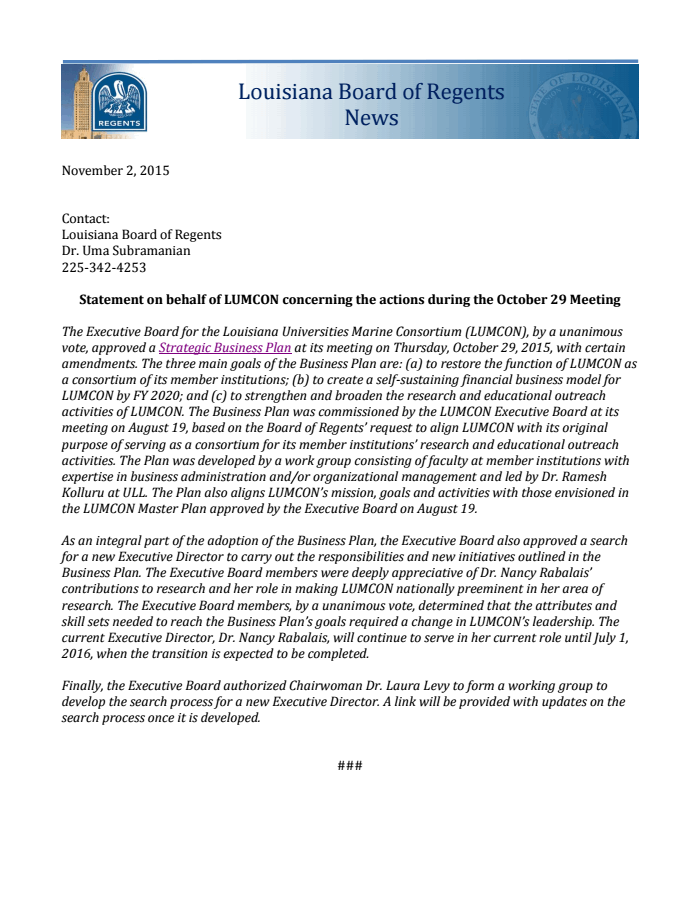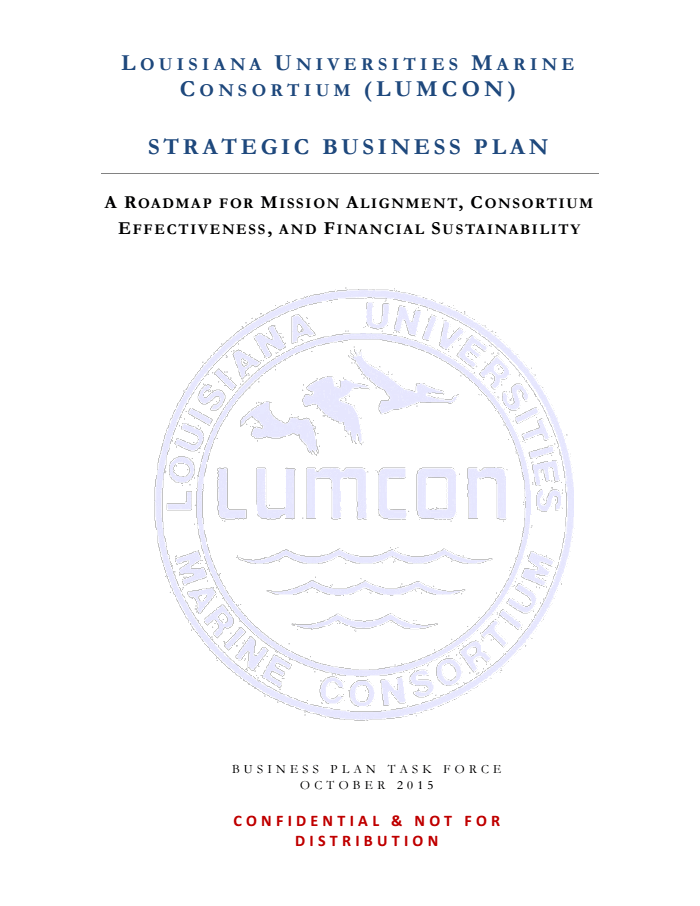‘Dead Zone’ researcher asked to step down as marine lab director
By By Mark Schleifstein, NOLA.com | The Times-PicayuneNovember 2, 2015
Nancy Rabalais, the marine ecologist whose research has outlined the devastating effects of the annual low-oxygen "Dead Zone" in the Gulf of Mexico, has been asked to step down after 10 years as executive director of the Louisiana Universities Marine Consortium(LUMCON), a marine laboratory operated by a consortium of state and private universities in Cocodrie, according to a statement released Monday (Nov. 2) by an executive board overseeing the laboratory.
LUMCON’s executive board on Oct. 29 unanimously approved a search for a new executive director as part of a vote on a new strategic business plan for the marine lab aimed at making it more financially sustainable in an era of plummeting revenue for the state’s universities. Rabalais’ last day as executive director would be July 1, 2016.
"The Executive Board members were deeply appreciative of Dr. Nancy Rabalais’ contributions to research and her role in making LUMCON nationally preeminent in her area of research," said the statement issued by the board Monday. "The Executive Board members, by a unanimous vote, determined that the attributes and skill sets needed to reach the Business Plan’s goals required a change in LUMCON’s leadership."
Uma Subramanian, deputy commissioner for legal and external affairs for the Louisiana Board of Regents, said the board hoped Rabalais would agree to continue to be a researcher at the marine lab.
"It is truly the board’s sincere hope that she stays in the state and continues to do research in her area," Subramanian said.
Rabalais could not be reached for comment on Monday.
It’s likely the research lab will need Rabalais, if only because a significant chunk of the research dollars held by the institution are for grants on which she is the lead researcher.
According to the board’s new strategic plan approved on Oct. 29, the marine lab is underwritten by $2.3 million it receives from the state each year. But it also has a carryover fund of $3 million available for 2016, with much of the money coming from two major grants listing Rabalais as the lead researcher.
Both were issued by the Gulf of Mexico Research Initiative, an independent marine science organization created within months of the BP Deepwater Horizon oil spill in 2010 with a $500 million grant from BP.
But the strategic plan suggested that tight budget times will require an executive director who spends much less time doing research and a lot more time fundraising by networking with academic, community, political, civic, industry and sponsor/agency leaders.
"Best practices suggest that the director, if a researcher, spend no more than 25 percent of time conducting and supervising research," the report said.
Rabalais is best known nationally as the researcher who oversees annual summer cruises that have measured the low-oxygen areas along Louisiana’s coastline that are known as the Dead Zone since 1985.
The lowest levels of underwater oxygen, referred to as hypoxia, kill sea life that makes its home on the bottom or burrows into the bottom, and causes shrimp and fish to move away.
Rabalais’ research has shown a link between modern use of agricultural fertilizers containing nitrogen and phosphorus to the low-oxygen conditions. When rainfall washes the nutrients off farmland in the Midwest and elsewhere in the Mississippi River watershed, it travels south, exiting atop saltier water in the Gulf of Mexico at the Mississippi’s Birdfoot Delta and from the Atchafalaya River.
The layer of fresh, high-nutrient water feeds blooms of algae that die and sink into the saltier water at Gulf’s floor along the coast, where it decomposes, creating areas with 2 parts per million or less of oxygen.
The low-oxygen conditions continue into the summer, until tropical storms, hurricanes or frontal systems stir up the Gulf and mix oxygen into the deeper waters. This year, the dead zone covered more than 6,400 square miles, larger than the states of Connecticut and Rhode Island combined, and three times the goal of voluntary federal and state efforts to cut down nutrients carried by the rivers.
The Research Initiative grants were for research on the effects of the BP oil spill in Louisiana waters.
Rabalais’ accomplishments also were heralded in 2012 with a five-year, $500,000 unrestricted "Genius Grant" from the John D. and Catherine T. MacArthur Foundation, presented to her for her hypoxia research.
The new business plan was developed by a task force created by the executive board in August that included professors from state universities who specialize in business management, marketing, economics and university research planning.
That group recommended dramatic changes to the way the lab now operates.
"While demand for this type of research is growing, especially in the aftermath of the BP Oil Spill crisis, the supply of state funds for LUMCON is decreasing due to budget cuts at the state level, particularly for higher education," the business plan said. "This situation is likely to remain the same in the near term, given the present price of oil and the state economy.
"LUMCON’s primary challenge in the next 3-5 years is to evolve to a more financially sustainable model of operations with a lessened dependence on state allocated dollars; one that supports universities in the development and dissemination of new knowledge; and one that invests in maintaining a world-class marine center to support research and education," it said.
The report said $460,000 of the annual state money LUMCON receives is for its role directing the operation of the Barataria-Terrebonne National Estuary Program, one of 28 such programs in the nation.
Another $400,000 is used to pay 75 percent of the salaries and benefits of the lab’s resident research faculty. It recommends encouraging faculty members to finance a greater share of their salaries by applying for grants, and recommended developing an incentive program to get researchers to go after more grant money.
The plan also calls for LUMCON to reduce its own offerings of education programs aimed at kindergarten to 12th grade students, and instead urging BTNEP to focus its outreach dollars at those students. LUMCON would still run less expensive "well-branded, higher-value programs" for elementary and high school students, such as summer camps for gifted and talented students.
The program also was critical of LUMCON’s using $146,000 a year to support a book-based library, and recommended a move to a cheaper, digital library, again with the assistance of BTNEP money.
The report said LUMCON was failing in its effort to be a consortium representing all the state’s universities, and recommended the hiring of a "university research coordinator" to build collaborations between the lab and universities that would bring in more money.
It pointed out that resident faculty members "seem to voluntarily spend significant portions of their time on some member university campuses, teaching courses and mentoring students."
"Unfortunately, their collaboration is not proportionally reciprocated by member institutions," the report said. "A review of research proposals initiated by member universities that include LUMCON resident faculty as (co-principal investigators) is disappointing."
As part of this change in strategy, it recommended that LUMCON researchers be expected to spend 100 percent of their time on research, rather than the present practice of spending 70 percent on research, 20 percent on teaching and 10 percent on service.
It also recommended finding ways of developing joint-hires for resident faculty members, where consortium universities would pay a greater share of their salaries, expenses and research costs.
Here’s a copy of the LUMCON Executive Board statement announcing the replacement of Rabalais as director of the marine laboratory:

Here’s a copy of the new LUMCON strategic business plan:

